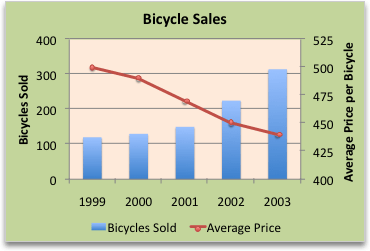-
Graphs And Charts Software For Mac카테고리 없음 2020. 2. 8. 22:53

'We've been using DataGraph for Mac for the last couple of months. Provided excellent graphs for a proposal, couple of papers, and talks with this lately, and it's. OmniGraffle is for creating beautiful, precise graphics. Available for. Use charts to represent data and processes with symbols, graphics, and connecting lines.
Nov 5, 2012 - Creating Line Graphs. If line graphs are what you need, you can create them in the same way as bar graphs. Line graphs do not have as many.
Statistical Comparisons. Paired or unpaired t tests. Reports P values and confidence intervals. Automatically generate volcano plot (difference vs. P value) from multiple t test analysis. Nonparametric Mann-Whitney test, including confidence interval of difference of medians.

Making Free Graphs And Charts
Kolmogorov-Smirnov test to compare two groups. Wilcoxon test with confidence interval of median. Perform many t tests at once, using False Discovery Rate (or Bonferroni multiple comparisons) to choose which comparisons are discoveries to study further. Ordinary or repeated measures ANOVA followed by the Tukey, Newman-Keuls, Dunnett, Bonferroni or Holm-Sidak multiple comparison tests, the post-test for trend, or Fisher’s Least Significant tests.
One-way ANOVA without assuming populations with equal standard deviations using Brown-Forsythe and Welch ANOVA, followed by appropriate comparisons tests (Games-Howell, Tamhane T2, Dunnett T3). Many multiple comparisons test are accompanied by confidence intervals and multiplicity adjusted P values. Greenhouse-Geisser correction so repeated measures one-, two-, and three-way ANOVA do not have to assume sphericity. When this is chosen, multiple comparison tests also do not assume sphericity. Kruskal-Wallis or Friedman nonparametric one-way ANOVA with Dunn's post test. Fisher's exact test or the chi-square test. Calculate the relative risk and odds ratio with confidence intervals.
Two-way ANOVA, even with missing values with some post tests. Two-way ANOVA, with repeated measures in one or both factors. Tukey, Newman-Keuls, Dunnett, Bonferroni, Holm-Sidak, or Fisher’s LSD multiple comparisons testing main and simple effects. Three-way ANOVA (limited to two levels in two of the factors, and any number of levels in the third). Analysis of repeated measures data (one-, two-, and three-way) using a mixed effects model (similar to repeated measures ANOVA, but capable of handling missing data). Kaplan-Meier survival analysis. Compare curves with the log-rank test (including test for trend).
Comparison of data from nested data tables using nested t test or nested one-way ANOVA (using mixed effects model). Nonlinear Regression. Fit one of our 105 built-in equations, or enter your own. Now including family of growth equations: exponential growth, exponential plateau, Gompertz, logistic, and beta (growth and then decay). Enter differential or implicit equations.
Enter different equations for different data sets. Global nonlinear regression – share parameters between data sets. Robust nonlinear regression. Automatic outlier identification or elimination. Compare models using extra sum-of-squares F test or AICc. Compare parameters between data sets.
Apply constraints. Differentially weight points by several methods and assess how well your weighting method worked. Accept automatic initial estimated values or enter your own. Automatically graph curve over specified range of X values. Quantify precision of fits with SE or CI of parameters. Confidence intervals can be symmetrical (as is traditional) or asymmetrical (which is more accurate). Quantify symmetry of imprecision with Hougaard’s skewness.
Plot confidence or prediction bands. Test normality of residuals. Runs or replicates test of adequacy of model. Report the covariance matrix or set of dependencies. Easily interpolate points from the best fit curve. Fit straight lines to two data sets and determine the intersection point and both slopes.
Column Statistics. Calculate descriptive statistics: min, max, quartiles, mean, SD, SEM, CI, CV, skewness, kurtosis. Mean or geometric mean with confidence intervals. Frequency distributions (bin to histogram), including cumulative histograms. Normality testing by four methods (new: Anderson-Darling). Lognormality test and likelihood of sampling from normal (Gaussian) vs.
Lognormal distribution. Create QQ Plot as part of normality testing. One sample t test or Wilcoxon test to compare the column mean (or median) with a theoretical value. Identify outliers using Grubbs or ROUT method. Analyze a stack of P values, using Bonferroni multiple comparisons or the FDR approach to identify 'significant' findings or discoveries. Linear Regression and Correlation. Calculate slope and intercept with confidence intervals.
Force the regression line through a specified point. Fit to replicate Y values or mean Y.
Graphs And Charting Software For Mac Australia
Test for departure from linearity with a runs test. Calculate and graph residuals in four different ways (including QQ plot). Compare slopes and intercepts of two or more regression lines. Interpolate new points along the standard curve. Pearson or Spearman (nonparametric) correlation. Multiple linear regression (including Poisson regression) using the new multiple variables data table.
Clinical (Diagnostic) Lab Statistics. Bland-Altman plots. Receiver operator characteristic (ROC) curves. Deming regression (type ll linear regression). Simulations. Simulate XY, Column or Contingency tables. Repeat analyses of simulated data as a Monte-Carlo analysis.
Plot functions from equations you select or enter and parameter values you choose. Other Calculations.
Area under the curve, with confidence interval. Transform data. Identify outliers. Normality tests. Transpose tables. Subtract baseline (and combine columns). Compute each value as a fraction of its row, column or grand total.